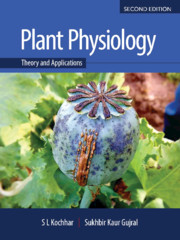Book contents
- Frontmatter
- Contents
- Foreword
- Preface to the Second Edition
- Preface to the First Edition
- Acknowledgements
- Some Common Abbreviations used in the Text
- Abbreviations for Units
- Unit I Water and Mineral Translocation in Plants
- Unit II Metabolism and Bioenergetics
- Unit III Growth and Development
- Unit IV Physiological Stress and Secondary Metabolites – Their Role in Metabolism
- Unit V Crop Physiology – An Innovative Approach
- Unit VI Breakthroughs in Plant Physiology
- Unit VII Some Experimental Exercises
- Glossary
- References
- Index
- Colour Plates
Chapter 13 - Phloem Transport
Published online by Cambridge University Press: 12 May 2020
- Frontmatter
- Contents
- Foreword
- Preface to the Second Edition
- Preface to the First Edition
- Acknowledgements
- Some Common Abbreviations used in the Text
- Abbreviations for Units
- Unit I Water and Mineral Translocation in Plants
- Unit II Metabolism and Bioenergetics
- Unit III Growth and Development
- Unit IV Physiological Stress and Secondary Metabolites – Their Role in Metabolism
- Unit V Crop Physiology – An Innovative Approach
- Unit VI Breakthroughs in Plant Physiology
- Unit VII Some Experimental Exercises
- Glossary
- References
- Index
- Colour Plates
Summary
Attempts to demarcate the two processes of transportation: of inorganic, as well as organic nutrients in plants, dates back to the 17th century. A plant anatomist, Malpighi conducted a experiment in which he separated a ring of bark (phloem) from the wood (xylem) of young stems by detaching the two in the region of vascular cambium - ‘girdling’ or ‘ringing’ (Figure 13.1). Since the xylem remained intact, water and inorganic solutes kept on rising all the way upto the foliar region and the plant remained alive for a few days. However, girdled plants showed swelling of the bark in the area just above the girdle due to accumulation of photo-assimilates flowing downward. The downward stream also consisted of nitrogenous compounds and hormones, which caused cell enlargement above the girdle. Ultimately, the root system was subjected to starvation because of lack of nutrients and the girdled plants died away.
Evidences in Support of Phloem Transport
1. An analysis of phloem exudate obtained by making an incision into the phloem tissue provides evidence, supporting the fact that photoassimilates are translocated through the phloem.
2. Aphid technique: Aphids, constituting groups of small insects, feed on herbaceous plants by inserting a long mouth part (proboscis) deep into individual sieve-tube elements of the phloem. While aphids are feeding, they are anaesthetized with a gentle stream of CO2 and the proboscis is carefully removed with a sharp blade. Meanwhile, the uncontaminated phloem liquid continues to ooze out from the cut proboscis for a long period (Figure 13.2). This demonstrates that phloem sap is under pressure. The aphid technique has proved to be of great use in understanding the mechanism of phloem transport.
3. Radioactive tracers: Evidence is also garnered by employing radioactive elements, specifically 14C on the leaves of herbaceous and woody plants. The radioautographs that follow, reveal that radioactive photoassimilates being transported out from the leaves, are confined to only the phloem tissue.
Composition of the Photoassimilates Translocated in the Phloem
The major component of phloem sap in most of the plants is sucrose. But, a small number of plant families translocate oligosaccharides of the raffinose groups (raffinose, stachyose and verbascose) and sugar alcohols (mannitol and sorbitol).
- Type
- Chapter
- Information
- Plant PhysiologyTheory and Applications, pp. 388 - 408Publisher: Cambridge University PressPrint publication year: 2020

